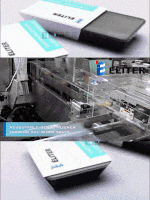The demand for PVC will grow and reach 57.7 million tons by 2031
2023-01-10
Indestructible, versatile and cost-effective: Polyvinyl chloride (PVC) is one of the oldest and most common plastics. The ban on PVC is being discussed for sanitary and environmental reasons. However, this material is gaining attractiveness again today, since it is made from by-products of the chemical industry and table salt, and not just petroleum. So far, at least, its success has been uninterrupted: PVC is the best-selling thermoplastic along with polyethylene and polypropylene. The latest Ceresana market study on polyvinyl chloride, which is already the seventh edition, forecasts that the demand for PVC will continue to grow and reach about 57.7 million tons worldwide by 2031.
Is PVC becoming environmentally friendly?
Flexible PVC, which contains large amounts of plasticizers, is especially controversial because it can release toxic chemicals and heavy metals during its production, use and disposal. However, there are advances in PVC recycling: in Europe, more than 810,000 tons are already recycled every year, that is, more than a quarter of all PVC waste. This means that the recycling rate of PVC is better than that of other plastics. In response to the European Union’s Chemicals Strategy and Circular Economy Action Plan, manufacturers and processors of PVC, plasticizers and stabilizers from the EU, Norway, Switzerland and the United Kingdom have made a voluntary commitment: the ‘VinylPlus’ initiative is designed to improve the recycling and, in general, the environmental performance of PVC. With bio-based PVC grades and bio-based additives made from renewable raw materials, PVC suppliers want to benefit from the rise of bioplastics.
The construction sector as the main client
With a share of around 60%, the construction industry is the most important customer sector for PVC and is expected to remain so in the future. In the construction sector, PVC is used for a wide range of applications, from flooring to roof panels, from window and door frames to cables and cable sheaths, anchors and fixings. The most important PVC products are pipes and pipelines, which account for more than 37% of the total PVC demand. They are followed by profiles, with 20.1%, and films and foils, with 18.1%. In 2021, more than 7.3 million tons of PVC were transformed into pipes for wastewater worldwide; the market for PVC pipes for drinking water and for industrial applications is somewhat smaller. Compared to concrete or metal, PVC pipes are much lighter, and PVC also stands out for its corrosion resistance and insensitivity to UV rays, chlorine and ozone.
Packaging of all kinds
The packaging industry ranks second, transforming 16% of the PVC produced in the world into flexible and rigid packaging: PVC is used to manufacture packaging films, bags and sacks, as well as shrink and stretch films, but also packaging such as butter or yogurt jars, bottles, boxes and lids. In general, PVC is used for many everyday products, such as credit cards, shoe soles, toilet seats and truck tarps. Its electrical properties make PVC suitable for insulating tapes and protective coatings of pliers or other tools. In medical technology, the high resistance of PVC to chemicals and disinfectants is an advantage, for example, in infusion bags, tubes, catheters and gloves.
Current rigid PVC and flexible PVC market data
Chapter 1 provides a presentation and analysis of the global polyvinyl chloride market, with forecasts up to 2031. PVC demand and revenue in each region of the world are explained. In addition, the global and regional demand is analyzed by product and by application area.
The following PVC products are examined in detail:
- Pipes for sewage
- Pipes for drinking water
- Pipes for other applications
- Profile
- Films and foils
- Cable
- Pavement
- Container
- Other PVC products
These areas of PVC application are examined:
- Flexible packaging
- Rigid packaging
- Construction
- Transport
- Electrical and electronics
- Industrial
- Other applications
Chapter 2 examines 46 countries separately:
- Demand
- Income
- Production
- Trade
- Demand for PVC product
- Demand by application
- Demand by type of rigid or flexible PVC
Chapter 3 provides profiles of the most important PVC producing companies, clearly sorted by contact details, revenue, profits, product range, production facilities, capabilities and brief profile. Detailed profiles of 82 manufacturers are provided, for example China National Chemical Corporation, Formosa Plastics Group, Ineos Holdings Ltd., Occidental Petroleum Corporation, Orbia Advance Corporation, Shin-Etsu Chemical Co., Ltd., Westlake Chemical Corporation and Xinjiang Tianye Co., Ltd.




